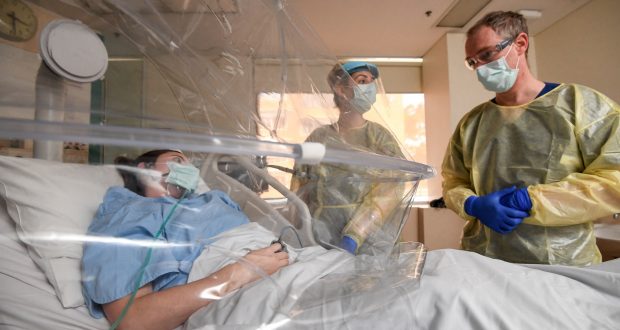We might not be able to see it, but whenever we speak or cough or hiccup, we expel a kind of ‘mouth rain’ – a shower of tiny droplets that is thought to travel at least 1.5 metres. It is through these droplets that coronavirus spreads.
Nurses, surrounded by a mist of potentially infected air and often without adequate PPE protection, are particularly vulnerable to cross-contamination. In countries like Spain, infection rates of healthcare workers are as high as 15 per cent.
To limit contagion in infected hospital patients and protect our essential healthcare workers, researchers at the University of Melbourne, in collaboration with Western Health, have developed ventilation hoods for hospital beds in ICU wards. Trials of the prototype begin this week at Melbourne’s Footscray hospital (operated by Western Health), and are expected to be used on COVID-19 patients as early as next week.
Resembling large, transparent pram canopies covering the patient’s upper half, these devices serve a double function to both contain and remove droplets.
University of Melbourne School of Engineering professor Jason Monty explains: “The hood helps to confine bigger droplets to a known area around the patient while smaller droplets are sucked away through an attached ventilation system and filtered out through a high-efficiency particulate air filter.
“People might know the N95 masks, and how they filter 95 per cent of droplets,” Professor Monty adds over the phone to Nursing Review. “The filter that we use is 99.97 per cent effective.”
The filter itself is a HEPA filter, which has a butterfly valve to ensure that what goes in can never come back out. The same filter is used in the industrial cleaning industry to remove asbestos.
A cleaning protocol is followed to ensure that no individual is ever exposed to the interior of the hood, and that filters are properly and safely disposed of.
The prototype was developed by Professor Monty and Associate Professor Forbes McGain, an intensive care specialist at Western Health, who is also an honorary fellow with the University of Melbourne's Centre for Integrated Critical Care. McGain was the first to approach the university with the idea.
The hoods have since undergone testing by fluid dynamics researchers in consultation with intensive care specialists, nurses and other infectious disease experts at Western Health.
“Our testing has shown that the hood allows healthcare workers to interact with their patients and get a visual sense of their condition through the clear plastic, but with a reduced risk of infection,” McGain said.
Made of PVC plastic, a frame and a plexiglass backing, the materials of the hood are low-cost and readily available. The hope is that the prototype will be able to be made anywhere in the world, including low to middle income countries.
Innovative strategies to protect healthcare workers against COVID-19 are being developed by institutes and universities everywhere, often in partnership.
The Murdoch Children’s Health Institute is hoping to enrol 4000 healthcare workers in a randomised, multicentre trial of the BCG vaccine against COVID.
Various teams at the University of Wollongong are working on 3D printed face shields for frontline doctors and nurses. And, in a recent article on The Conversation, an adjunct professor of architecture at the University of Adelaide suggested that something as simple as automatic doors could do a lot to minimise transmission in hospitals.
The ventilation hood offers one more important safeguard which can be easily rolled out to potentially save lives.
Email [email protected]
 Aged Care Insite Australia's number one aged care news source
Aged Care Insite Australia's number one aged care news source

